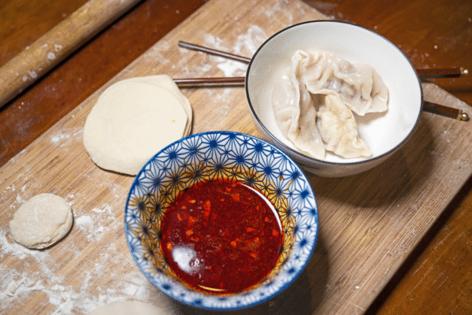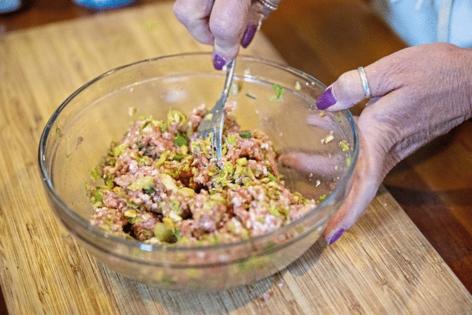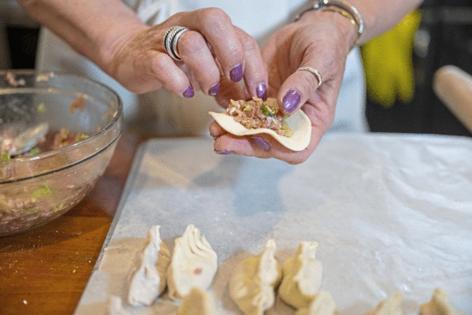How to make Chinese dumplings at home
Published in Variety Menu
When it comes to Chinese comfort food, nothing beats a really good bowl of hand-pulled noodles or a steaming, silky bowl of mapo tofu. Yet our love affair with Chinese food often centers around dumplings.
Whether they're boiled, steamed or pan-fried, it's just so easy to eat five, six or even a dozen of the plump and juicy dough bundles stuffed with ground meat and/or vegetables. And you don't even need to head to your favorite Chinese restaurant or order takeout to enjoy them.
With a bit of practice, most home cooks will find jiaozi fairly easy (and fun!) to make, especially if you get an assembly line going and opt for pre-made wrappers.
Because they're shaped like ancient Chinese ingots, dumplings are often a celebratory food in China, enjoyed during holidays such as the Lunar New Year, when they symbolize wealth and prosperity for the upcoming year. But that's not always the case. Former Pittsburgher Hannah Che, who wrote the James Beard Award-winning "The Vegan Chinese Kitchen" in 2022, grew up eating them any time the family got together.
Dumplings take quite a few forms in China, depending on the province and region, says Che. Since both parents are from northern China, her family mostly ate boiled dumplings. Dumpling-making was also very much a joint effort, with her father rolling the homemade dough wrappers, most everyone else filling and pleating them and her mom handling the cooking.
It would have been quicker and easier to use the inexpensive frozen wrappers you can find in any Asian market, and she's quick to point out there's no shame in going the convenience route. In fact, this is how many Chinese home cooks make dumplings.
"It's just we always made the dough from scratch," Che says on an early morning phone call from Dali in China's southwestern Yunnan province, where she is working on a second cookbook that will focus on tofu.
Dumpling do's and don'ts
Dumplings from scratch are better for one simple reason: texture.
"Homemade dumplings just always have a more satisfying mouth feel," Che says.
Also, scratch wrappers only require mixing all-purpose flour and water, then letting the dough rest for a little bit to become smooth and silky before kneading and rolling it out. "You don't need any leavening."
That said, she still has some tips to make rolling, stuffing and pinching homemade dumplings a little easier for beginners.
For starters, if you're going to boil the dumplings, it's important to use cold water when mixing the dough because it will give you a thicker skin. Otherwise, they will fall apart in boiling water. (If you're going to pan-fry the dumplings, however, use hot water for a more delicate wrapper.)
You need to get the proportion of water to flour just right; if it's too soft, it will fall apart under the weight of the filling. This is the one time you might consider using a scale to weigh both water and flour.
"It should be really elastic, but still stiff," Che says.
Take a rest
It's also essential to allow the dough to rest on the counter (to relax it and make it easier to roll), and aim for consistently sized portions when you pinch or cut the dough after rolling or spinning it into ropes.
Rolling the dough between two pieces of parchment paper eases the process. You also might consider using a tortilla press if you've got one handy — especially if you're intimidated by the thought of all that rolling.
"It's a definite time saver!" she says.
The wrappers don't have to be a perfect circle, just roundish.
When it comes to preparing a meat filling, combinations are endless, but Che says it's important to add in some chives, green onions or chopped cabbage "so there is something juicy (but not watery) in there besides the meat."
If you'd rather go vegetarian, you need similar aromatics along with "something meaty" like tofu or tofu skin to give the dumpling some heft.
"You can also include vermicelli or glass noodles because you can chop it up really nice, and it adds this richness and texture to the filling that is really satisfying," she says.
Just be sure to squeeze a vegetarian filling to remove any excess water. And you'll also want to go heavier on the salt than you would ordinarily on both varieties because the dough wrapper will subdue the seasonings.
Mixing and stuffing
Another time-saver: Use a food processor instead of mixing all the ingredients by hand.
"It really saves a lot of time, and you want something pasty," says Che.
Now you're ready to stuff and pleat the bundles.
Since the primary goal is to keep the filling inside, and elaborate pinches take a lot of practice, settle for a basic half-moon shape unless you really want to make it look pretty. This is especially true if you're simply going to boil them, says Che. Fancy edges are more for steamed dumplings served for dim sum, where the presentation is more refined.
Make sure the finished dumplings are flat on the bottom. It makes them easier to pick up with a pair of chopsticks.
Che's final words of advice: Find a partner or, even better, several.
"Dumpling making is definitely more enjoyable when it's a communal activity," she says.
All those bodies working in unison, in fact, is what makes dumplings a celebration food in Chinese culture.
"It takes so long, you might as well have lots of hands," she says, laughing.
Homemade jiaozi (dumplings)
PG tested
This dough comes together, rolls out easily and can be used regardless of filling or the cooking method. Since I was making them by myself, I halved the recipe for a smaller batch of about 50 dumplings stuffed with a classic cabbage-and-pork filling.
If you're going to freeze the dumplings, place them in a single layer on a cookie sheet and freeze until hard before storing in a plastic bag.
For an easy dipping sauce, stir together 2 tablespoons of black vinegar, 2 tablespoons of soy sauce, a pinch of sugar and a heaping teaspoon (or more) of chili crisp, chili oil or sriracha.
For dough
4 cups (560 grams) all-purpose flour, plus more for dusting
3/4 teaspoon salt
1 cup plus 3 tablespoons (280 grams) cold water
For filling
1 pound ground pork
1 tablespoon minced fresh ginger root
4 cloves garlic, minced
2 tablespoons thinly sliced green onion
4 tablespoons soy sauce
3 tablespoons sesame oil
1 cup finely chopped Chinese cabbage
Prepare dough. Put flour in a large bowl and add all the water. Mix together with a pair of chopsticks until all the flakes come together in a shaggy ball. Start kneading dough with your hands and incorporate any remaining flour. Let rest 5 minutes, then knead again until it is taut, smooth and firm, about 7 minutes.
Cover with a tea towel and allow dough to rest for 15 minutes. Dough should feel slightly tacky, but not damp.
While dough is resting, prepare filling. In a large bowl, combine pork, ginger, garlic, green onion, soy sauce, sesame oil and cabbage. Stir until well mixed.
Once rested, divide dough in half. Form one portion into a ball, poke a hole in the center and shape like a doughnut. Lift dough so gravity causes the bottom to stretch and gently shape with your hands as it grows skinnier, forming an O-shaped rope.
When the rope is 3/4 inch in diameter, break doughnut into a long rope and tear off 3/4 -inch pieces with a sharp, quick snap of your wrist. (They should weigh about 10 grams.) You can also use a knife or pastry scraper. Dust pieces with flour and repeat with remaining dough.
Roll each piece into a small ball, then flatten it between palms to create a disc resembling a wafer cookie. Press thumb into dough to create a "belly" in the center.
Roll dough ball into a circle about 3 inches in diameter. (The edges should be thinner than the center.) Don't worry if it's not perfect; it only needs to be roundish. The key is to keep size consistent so dumplings cook consistently.
Place 2 teaspoons of filling onto each dumpling round. If you don't want to pleat the dumplings, the easiest way to seal them is to fold the wrapper over the filling into a half-moon shape. Match the edges together and press as if you were sealing an envelope. There is no need to seal homemade wrappers with water. (There is enough moisture in the dough to seal.)
Hold sealed edge of dumpling between fingers, press bottom belly of the dumpling into a board so it stands up. Place on baking sheet lined with parchment paper and repeat with remaining dumplings.
To boil: Bring 4 quarts water to a boil. Add 10-12 dumplings and gently stir. When water returns to a boil, add 1 cup of cold water and bring water back to a boil. Dumplings are done when they are puffed up and floating on the surface, about 5 minutes. Remove from pot to plate with a large slotted spoon or strainer.
To steam: Line steamer basket with steamer paper and place prepared dumplings in a single layer in the basket, with 1 inch between each. Place basket on top of pot and steam, covered, for 8-10 minutes, or until wrappers puff up. (Meat fillings will take longer.)
To pan-fry: Preheat a 9-inch skillet over medium heat for 1 minute. Add enough vegetable oil to coat bottom surface, then carefully arrange dumplings in a single layer, flat side down. Add 1/2 cup water to skillet and cover immediately. Cook for 7-9 minutes, until water has evaporated and bottoms of dumplings are golden brown.
Makes about 48 dumplings.
— adapted from "The Vegan Chinese Kitchen" by Hannah Che (Clarkson Potter, $35)
©2024 PG Publishing Co. Visit at post-gazette.com. Distributed by Tribune Content Agency, LLC.












Comments